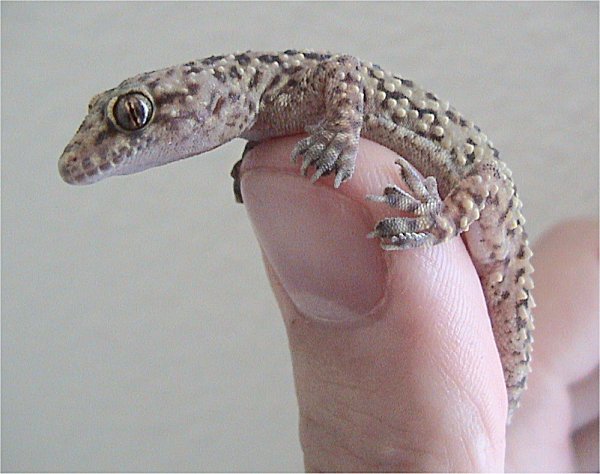|
| Query: canaries | Result: 368th of 381 | |
Mediterranean House Gecko (Hemidactylus turcicus) - Wiki
| Subject: | Mediterranean House Gecko (Hemidactylus turcicus) - Wiki
| |

| Resolution: 600x474
File Size: 53945 Bytes
Upload Date: 2007:06:19 14:50:13
|
Hemidactylus turcicus
From Wikipedia, the free encyclopedia
[Photo] Mediterranean Gecko, Hemidactylus turcicus. Photographer: User:Dawson http://en.wikipedia.org/wiki/User:Dawson
Mediterranean House Gecko, Hemidactylus turcicus is a species of gecko. They are nocturnal and insectivorous, and rarely exceed six inches in length. They have large, lidless eyes and yellow, or tan colored skin with black spotting on the body, and often striping on the tail. Their bellies or undersides are somewhat translucent. Though technically an invasive species, its small size and habits do not typically make it a threat to populations of native animals. It is the only gecko in the United States with elliptical eye pupils. They are attracted to outside lights in search of insects. It is a voracious feeder of moths and small roaches. They have a distinct voice, somewhat like a bird chirping or a squeak,high pitched and thought to be a territorial message. These Geckos are currently multiplying strongly in Texas and other Southern USA states- except Florida where other non native Geckos have driven them out. There are few species in the Southern USA that feed on them since they are strictly nocturnal and hide in rafters and eaves during the day. Birds would eat them but since these Geckos only appear at night, birds are not a big threat. This species will spread and it appears very hardy to pesticides, unlike many reptiles and amphibians.
Description
Snout rounded, about as long as the distance between the eye and the ear-opening, 1.25 to 1.3 the diameter of the orbit; forehead slightly concave; ear-opening oval, oblique, not quite half the diameter of the eye. Body and limbs moderate. Digits rather variable in length, the inner always well developed; 6 to 8 lanmellae under the inner digits, 8 to 10 under the fourth finger, and 9 to 11 under the fourth, toe. Head anteriorly with large granules, posteriorly with minute granules intermixed with round tubercles. Rostral four-sided, not twice as broad as deep, with median cleft above; nostril pierced between the rostral, the first labial, and three nasals; 7 to 10 upper and 6 to 8 lower labials; mental large, triangular, at least twice as long as the adjacent labials, its point between two large chin-shields, which may be in contact behind it; a smaller chin-shield on each side of the larger pair. Upper surface of body covered with minute granules intermixed with large tubercles; these are generally larger than the interspaces between them, suboval, trihedral, and arranged in 14 or 16 pretty regular longitudinal series. Abdominal scales small, smooth, roundish-hexagonal, imbricate. Males with a short angular series of 4 to 10 (exceptionally 2) preanal pores. Tail cylindrical, slightly depressed, tapering, covered above with minute scales and transverse series of large keeled tubercles, beneath with a series of large transversely dilated plates. Light brown or greyish above, spotted with darker; many of the tubercles white, lower surfaces white.
Geographic distribution
The "med gecko" is one of the most successful species of geckos in the world. Originally native to southern Europe, it has spread over much of the world and established stable populations far from its origins. Due to this it holds no threatened or endangered status. It can be found in: Portugal, Spain, France, Italy (including Lampedusa island, Elba), Albania, Greece, (incl. Kalymnos, Paros, Antiparos, Despotiko, Lesbos, Chios, Limnos, Samos, Samothraki[, Milos, Tinos), Malta, Yugoslavia: coastal Croatia (except western Istria), Adriatic islands, Turkey, northern Morocco, Algeria, Tunisia, Libya, Egypt, Israel, northern Yemen (Socotra Archipelago), Somalia, Eritrea, Kenya, southern Iran, Iraq, Oman, Pakistan, India, Balearic Islands (Island Addaya Grande), Canary Islands (introduced to Gran Canaria and Tenerife), Panama, Puerto Rico, Belize, Mexico (Baja California, Chihuahua, Durango, Nuevo Leon, Yucatan; introduced), Cuba (introduced). It has also been introduced to the southern USA (Louisiana, Alabama, Texas, Arizona, Florida), Arkansas, Mississippi, South Carolina, Georgia, Oklahoma, Virginia, Maryland, California, Nevada, New Mexico, Kansas)
http://en.wikipedia.org/wiki/Hemidactylus_turcicus
| The text in this page is based on the copyrighted Wikipedia article shown in above URL. It is used under the GNU Free Documentation License. You may redistribute it, verbatim or modified, providing that you comply with the terms of the GFDL. |
|
Comments |
|---|
| | Bonnie |
|
| I have what I thought was a House Gecko until I bought one at PetSmart. they don't look anything alike. My 1st one I found outside my condo on the wall late tnight in the summer and I saw numerous other ones too tiny little things, like only a couple inches long. I have had that one now for about 4 years. Then one day while in PetSmart I saw a House Gecko for sale which I bought for a very little price ($7.00) and when I brought him home he looked nothing like the House Geko I had. This one was smooth and alot darker then the one I had. The one I had is bumpy and a light greyish-green. Now which is the real House Gecko? |
| | martin casco |
|
| Does anyone know, besides birds what eat Hemidactylus? I am particularly interested in H. frenatus. thanks ????? |
| | Guest |
|
| that geco is the cutest thing i have ever seen!And im 8. |
^o^
Animal Pictures Archive for smart phones
^o^
|
|
|